You know you need a competitor analysis for your email marketing campaign. You’ve sat down to do it three times, but it felt overwhelming. You’re wondering what you should even be comparing and how.
Competitive analysis is an important part of any business plan. You want to serve your target audience better than your competitor. More than that, you want to gain a competitive advantage.
You want to keep up with market trends, industry benchmarks, and create a solid workflow. Sit back, relax, and use a template! You can use the help of analysis tools and templates to streamline your strategic planning process.
A competitive analysis template makes it easy to visualize your analyses. There are templates for nearly every project management and spreadsheet platform out there. Plus, there are a few different types of competitor analyses.
In this guide, we’ll be focusing on email marketing competitor analyses. Keep scrolling to find out if you need a competitor analysis, which templates to use, and how to get a template for free.
What is a competitor analysis template?
A competitor analysis template outlines the competitive analysis process. It’s used to compare a company’s strengths and weaknesses to those of its competitors. They provide a bird's eye view of the competitive landscape to inform your business strategy.
The template typically includes sections for each competitor, including information about their products or services, pricing, customer base, market share, financials, marketing strategies, and more. It is used to help a company understand how to make its offerings more attractive than its competitors.
When should I do a competitor analysis?
As long as you have a product or service in development or on the market, there’s no wrong time to do a competitor analysis. Most companies do a competitor analysis before launching a new offering. But analyses like these can also be useful if your marketing efforts or sales stagnant.
Here are the best times to do a competitor analysis.
- Before you launch a new product, service, campaign
- Annually – your industry landscape can evolve quickly!
- If your marketing campaign isn’t performing as well as you’d hoped
When it comes down to it competitor analysis is another form of market research. It allows you to boil down your unique value proposition by noticing where you differ from your competitors. It’s a vital process for product managers and marketing campaigns.
Doing a competitor analysis will also help you identify areas of improvement and opportunities to differentiate yourself from competitors. Additionally, it can provide insight into what your customers value in a product or service, allowing you to make informed decisions about updates or improvements to your own offerings.
How do you structure a competitor analysis for email marketing?
The easiest way to structure your competitor analysis is in a spreadsheet or project management tool. This way, it’s visually easy to navigate, and you can share it with your team.
No matter how you decide to structure your competitor analysis, you should include these attributes. If you need help identifying any of these attributes, check out our complete guide to competitive analysis.
- Your direct competitors (you can also add indirect competitors)
- Both of your products or services
- Both of your email marketing stats
- The benefits of both of your offerings
- Opportunities for improvement for both of your offerings
Competitor Scorecards a.k.a. Side-By-Side Comparison
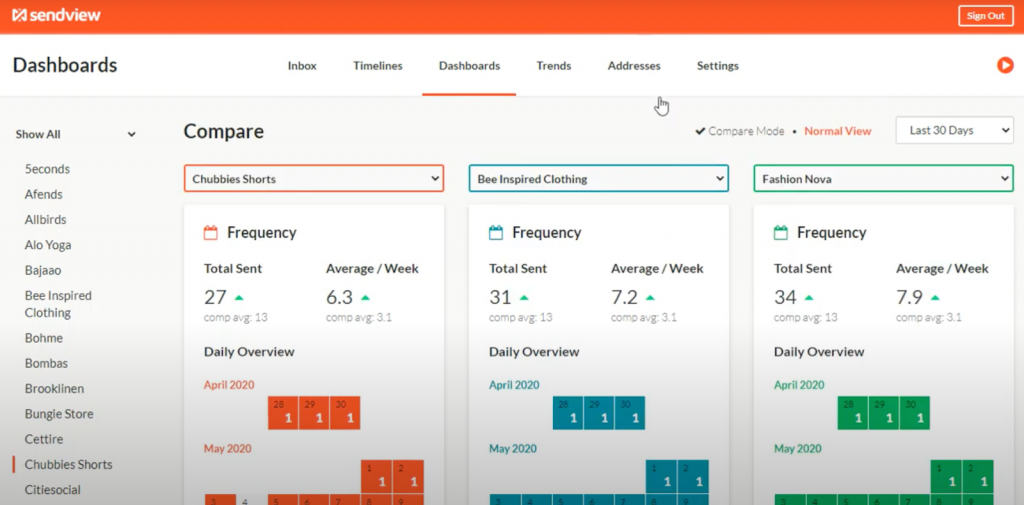
A competitor scorecard is an overview of a business’s direct competitors used to analyze and compare marketing practices. It typically includes competitors’ products and services, pricing, market share, and customer base. In email marketing, a competitor scorecard should also track the competitor's marketing strategies, such as tactics and KPIs.
Competitor scorecards can be an easy way to execute a side-by-side comparison at a glance. The best thing about them is that you can easily refer back to them and update them next year when you do your annual analysis.
Marketing Stats Competitive Analysis
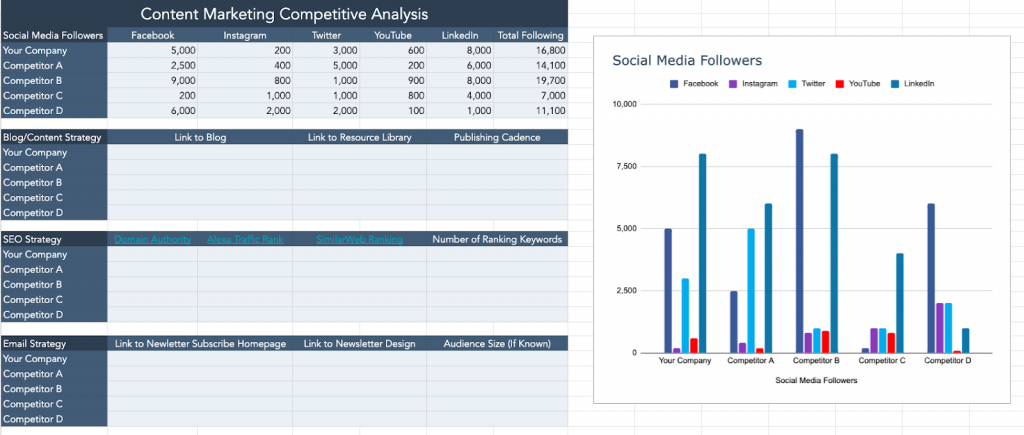
It makes sense to do an analysis of all of your competitor’s marketing stats if you’re competitive analysis is for your entire content marketing landscape–not just email analysis. In a marketing stats competitive analysis, you’ll gather your competition’s data from all of the marketing channels that you want to compare. SEO, social media, email, and blog content are great metrics to consider.
SWOT Analysis

We’ve talked about SWOT before, and we’ll do it again! Why? Because it’s the best way to dive deep into your competitors to garner a bigger market share.
SWOT stands for strengths, weaknesses, opportunities, and threats. You’ll go through each of these categories for both yourself and your competitors and then make a comprehensive plan to make your marketing more competitive.
You can lay out your SWOT analysis in quadrants. Create one for each competitor you want to compare, including your own company. Miro is great for this because their unlimited board size and easy copy-and-paste templates allow you to analyze as many competitors as you want.
Review Tracker
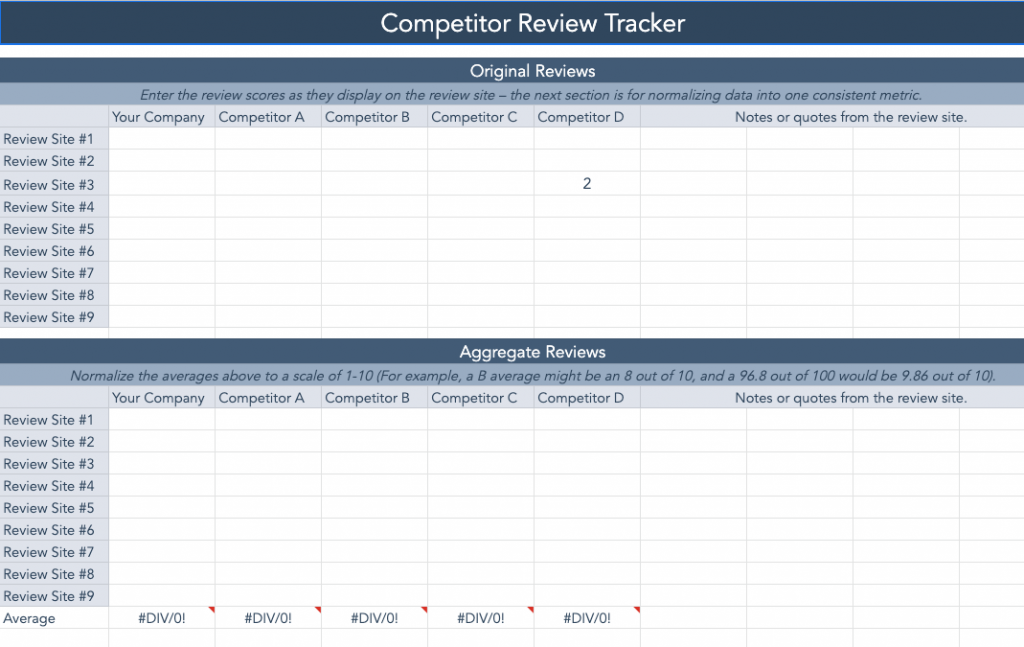
A sneaky way to spy on your competitors is through a review tracker. Every industry has review sites that allow you to see what people think of a product or service. The easiest way to determine your competitor’s weaknesses is through their reviews. You can use this to inform your SWOT analysis, too.
Set up a spreadsheet with your company and as many other companies as you want to track. Then, make a list of all of the review sites where you might find this information.
You can either track this in quantitative or qualitative terms. For a quantitative tracker, create a grading scale and find their averages. For qualitative analysis, pull opportunities for improvement from the comments you see on the review site.
The 7 Best Free Competitor Analysis Templates
Don’t overthink it. Save time on your competitive analysis by using a template! There are heaps of templates out there for analyses of all kinds. So, we rounded up the best free competitive analysis templates for you. Some are on project management apps, while others are Excel-style spreadsheets.
1. Miro’s Competitive Analysis Templates
The benefit of using Miro for competitive analyses is that you can expand the board as far as you want. It offers a visual way to compare your competitors that’s flexible and shareable. Try this SWOT template.
2. HubSpot’s Competitor Analysis Spreadsheet
This spreadsheet template from HubSpot contains ten templates for competitor analysis. Find the right one for you whether you’re looking for a competitor profile template or a content marketing analysis. It even autogenerates graphs! It’s in Google Drive, so it’s easy to share and edit. You could easily download this as an Excel sheet if your company is team Microsoft Office, too.
3. Competitive Analysis from ClickUp
ClickUp offers a fantastic chart-style SWOT template for competitive analysis that’s very visual. It’s similar to the option from MIRO. Their competitor tracking template or this one for SEO competitor analysis are also great options. They have templates for analyzing your competitor’s website, customer experience, and more.
4. Notion Competitor Analysis Dashboard
You’re not into Notion or ClickUp? Maybe Notion is more your speed! Try this free template. You can filter and sort, change views, and add as many competitors as you want. Analyze your competitor's strengths, product features, target market, and more in one place.
5. Xtensio Competitor Analysis Template
This template is a great way to document the strengths and weaknesses of each competitor alone as well as relative to each other. This can help you identify ways you can position yourself against other companies and work through risks.
6. Smartsheet Analysis Template
Smartsheet's template is a nice, visual way to organize competitor marketing assets, strategies, and real estate. If you're looking to analyze a long list of competitors you may have to use a few copies of this template, but each will be a clean, succinct compilation of the key insights and opportunities that may exist against each competitor.
7. Hubspot Template Download
You will need to enter an email address to download Hubspot's version, but it provides another clean, simple option for analyzing the key marketing channels and strategies for each of your competitors without adding too much fluff or filler that won't effect your own strategy relative to theirs.
How to use a competitive analysis template
Using a competitive analysis template is easy! Whether you’re using a template for your small business, or startup, or to inform your stakeholders, it’s not as complicated as it may seem. Let’s walk through it step-by-step.
Step 1: Duplicate the template
You may want to use the template again later, so we recommend making a duplicate of the template before you start filling it in.
Step 2: Fill in your information
Start with the easy stuff first. Fill in your own company’s information. When you’re conducting a competitor analysis, you’ll need to compare your own data to your competitors. Since you already know your info, add it first.
Step 3: Add your competitors – one at a time
Next, add each of your competitors, one at a time. If you’re doing a SWOT analysis, create a new quadrant competitor analysis chart for each competitor. This is where it comes in handy to have the original, unaltered template!
Step 4: Analyze
Now that you have all your information in your analysis template, it’s time to analyze. This guide will help you determine what to pay attention to in your analysis.
Step 5: Plan
After your analysis, you should have a clear idea of what you want to change or add to your marketing plan. With a deeper understanding of what your competitors are doing, it becomes easier to create a competitive campaign.
Key insights when analyzing your competitors' email strategy
You'll notice that in many of these templates there isn't a place for email. Despite being the most effective marketing channel for many businesses, due to the challenge of collecting the data email can be one of the harder ones to analyze. Luckily, SendView solves much of that leg work. Here are five things to track when building a template to monitor your competitors' email strategy.
1. Sending Volume / Frequency
The first big question is to understand how many emails your competitors send on both the aggregate as well as the individual company. The aggregate will show you the average email campaigns each brand sends during a given period and the individual stats will help you put those numbers side-by-side to see how each one compares.
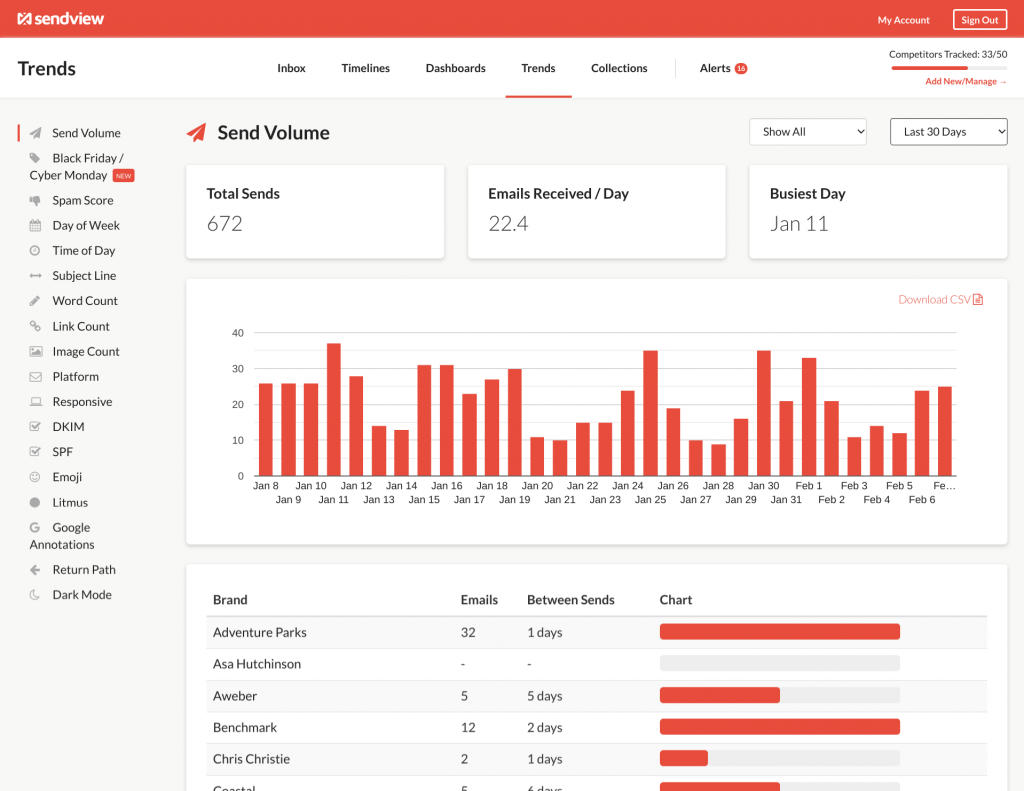
2. Email Tools / Tech Stack
Next, dig into their tech stack and understand what each competitor is using for an ESP, if they are using any additional tools for coding or analytics, what coding practices they're optimizing for like dark mode, and whether they're signing their emails with DKIM and SPF for deliverability. Analyze how they build out each template to look for opportunities to build emails that render better than your competitors.
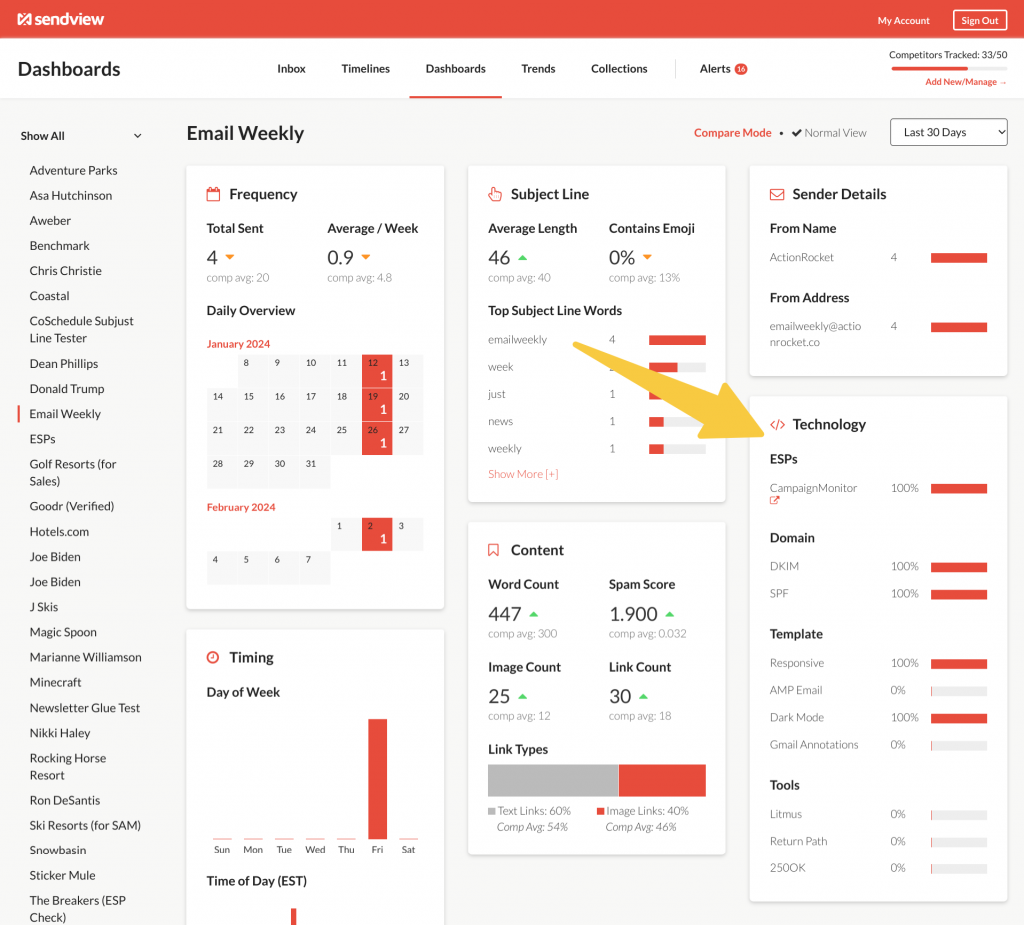
3. Time of Day Strategy
Understanding what time of day your competitors send emails is a key part in planning your own time-of-day sending strategy. Dig into the aggregate to see when quiet and busy spots are across your industry and then analyze individual senders you compete against and even individual email templates to find for opportunities to beat them to the inbox during key moments and campaigns.
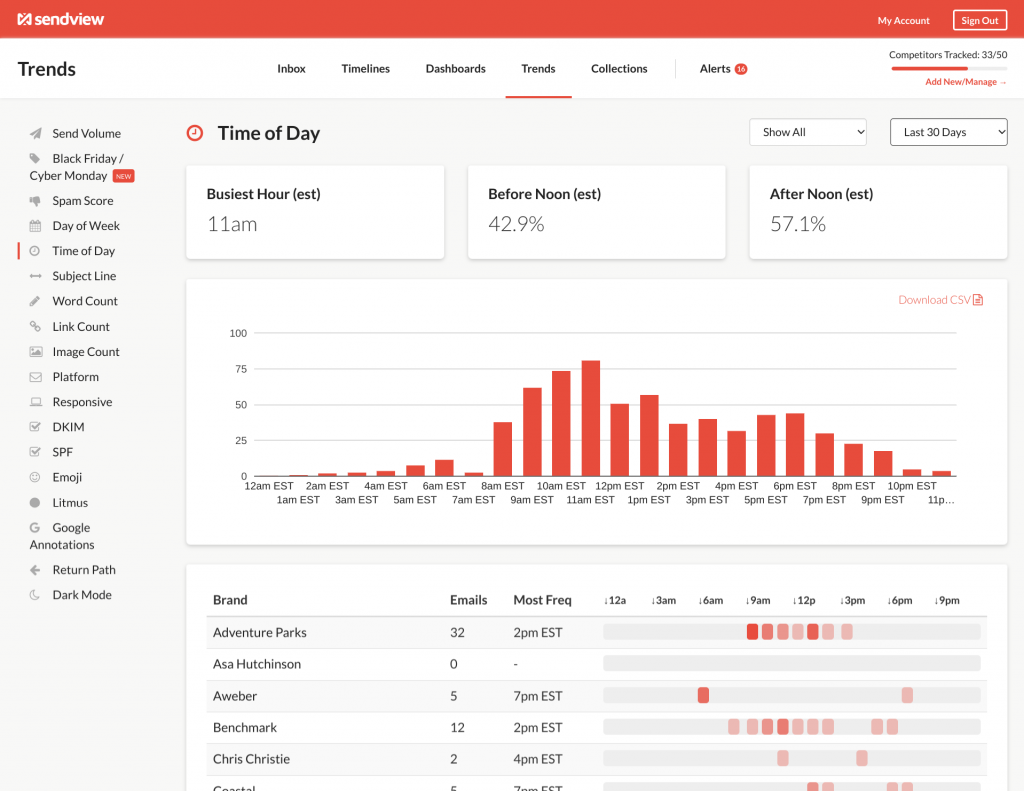
4. Spam Score
Spam score is a simple, insightful look at how some inboxes may view your competitors' emails. High spam scores don't necessarily mean those campaigns ended up in junk, but they are a good indicator of their approach to email templates, content, and technology that might increase the likelihood those campaigns aren't reaching the inbox.
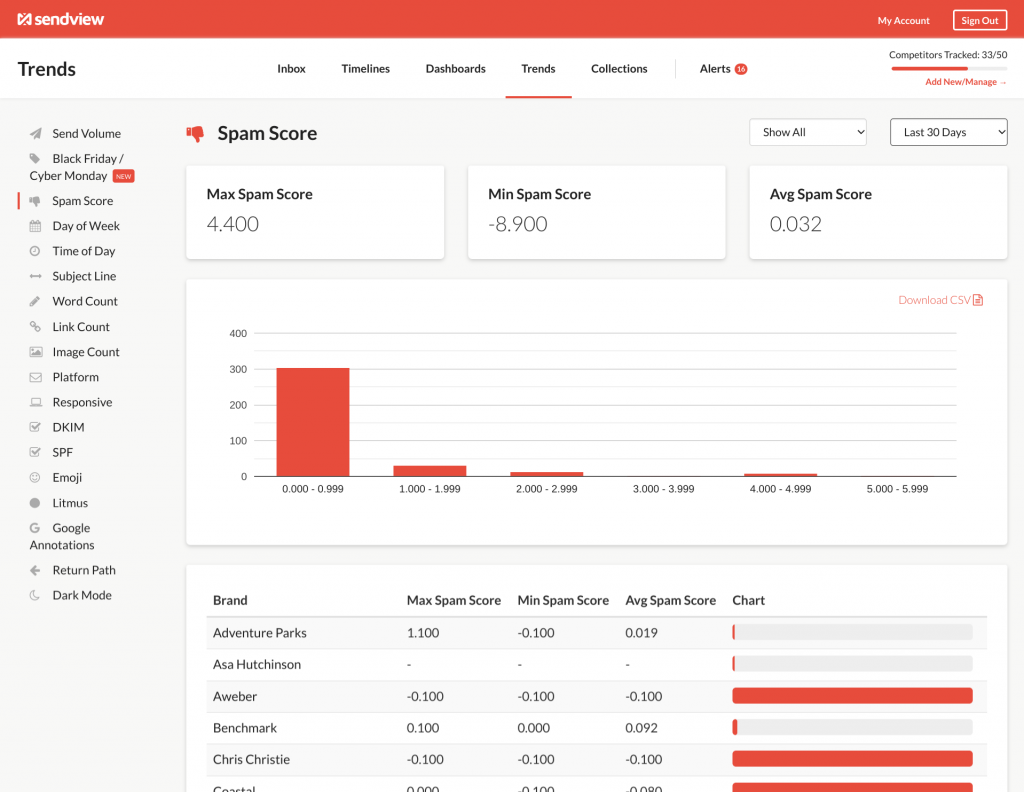
5. Word Usage
While you can track any number of factors, the last one we'll mention is word usage. Looking at which words they're using to introduce an email template and understanding how they're describing the products or services they sell can provide key insights into how you position yourself relative to each competitor. Analyzing word usage is one of the easiest way to refine your message vis-a-vis these companies.
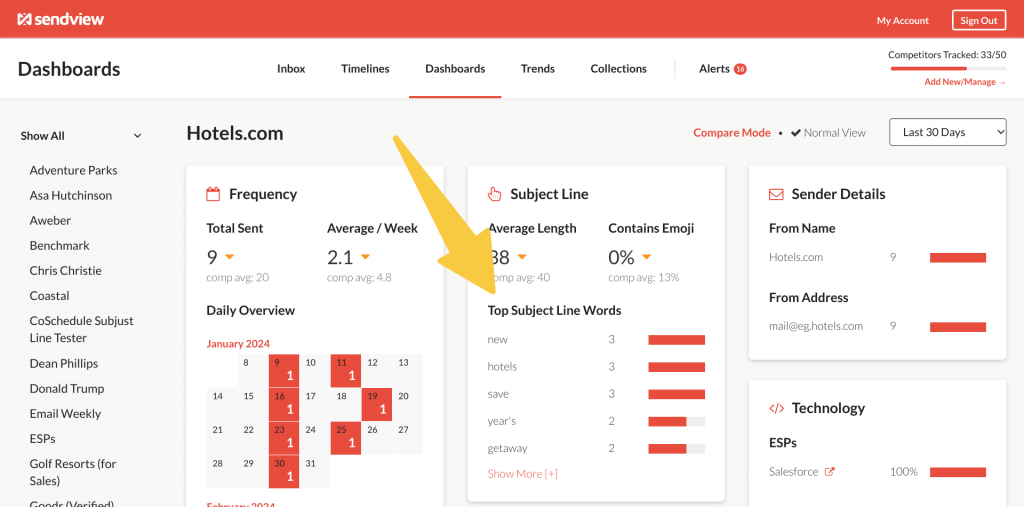
How do you use competitive analysis to make strategic decisions?
The easiest way to use a competitive analysis template to make your email marketing plan is by noticing the opportunities. Try asking these questions to inform your analytics and planning.
- Where are our competitors letting their customers down?
- Which KPIs are low? What do they indicate?
- In what ways are their designs lacking?
- Does their messaging speak to the benefits of their product rather than the features?
- Are they answering FAQs?
- How can we do better than our competitors in these areas?
Can I use this template for website, SEO, or other competitor analysis projects?
Probably not. We're an email marketing company who has built a competitor analysis tool called SendView, so this analysis is focused on email. There may be ways you can use parts of this template as inspiration for your own efforts, however.
For example, we help brands track with email marketing tools their competitors are using. This has historically been really hard to track, but now that marketers can see this their analyses have gotten much more insightful. A similar concept would be tracking with your competitors' change their website's CMS, when they start using a new social posting platform, or when they add new meta or other tags to their website. These are sometimes overlooked but can be really helpful to know when trying to understand how to beat your competitors in this crazy game of marketing.
What’s next?
Templates aren’t so overwhelming now, are they? Now, all you have to do is pick the template that you like and fill it in! If your company is already using one of the project management tools we listed here, go with that one. Your co-workers will thank you.
Here’s an overview of what you should do next.
- Pick a template
- Fill in your information
- Add your competitor’s information
- Analyze
- Plan
A competitor analysis template doesn't do all the work for you, but picking the right one can be a key strategy when taking all that information and putting it into a simple, actionable form for you and your team.


 Gregg Blanchard February 2, 2023
Gregg Blanchard February 2, 2023